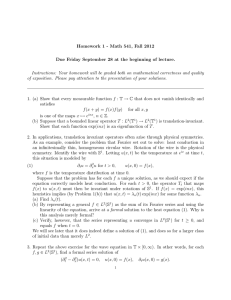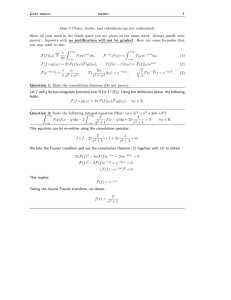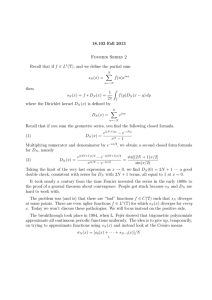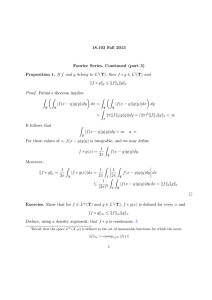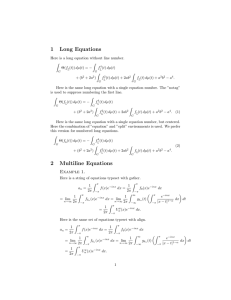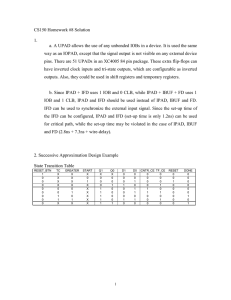18.103 Fall 2013 1. Fourier Series, Part 1.
advertisement
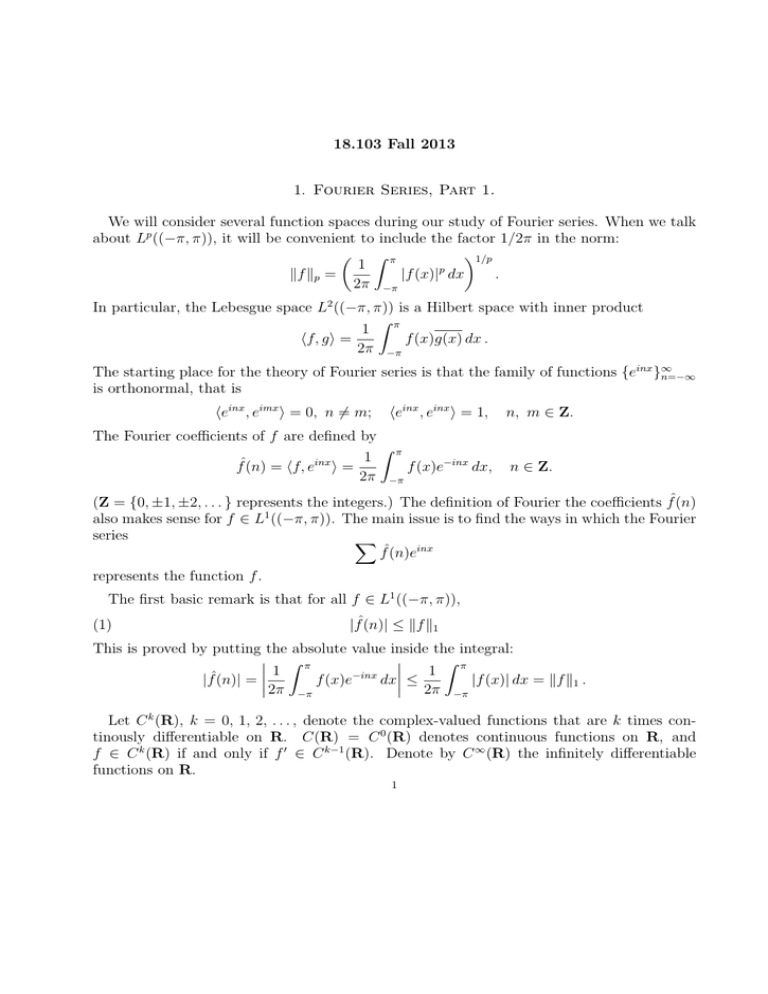
18.103 Fall 2013
1. Fourier Series, Part 1.
We will consider several function spaces during our study of Fourier series. When we talk
about Lp ((−π, π)), it will be convenient to include the factor 1/2π in the norm:
1/p
Z π
1
p
|f (x)| dx
.
kf kp =
2π −π
In particular, the Lebesgue space L2 ((−π, π)) is a Hilbert space with inner product
Z π
1
hf, gi =
f (x)g(x) dx .
2π −π
The starting place for the theory of Fourier series is that the family of functions {einx }∞
n=−∞
is orthonormal, that is
heinx , eimx i = 0, n 6= m;
heinx , einx i = 1,
The Fourier coefficients of f are defined by
Z π
1
inx
ˆ
f (x)e−inx dx,
f (n) = hf, e i =
2π −π
n, m ∈ Z.
n ∈ Z.
(Z = {0, ±1, ±2, . . . } represents the integers.) The definition of Fourier the coefficients fˆ(n)
also makes sense for f ∈ L1 ((−π, π)). The main issue is to find the ways in which the Fourier
series
X
fˆ(n)einx
represents the function f .
The first basic remark is that for all f ∈ L1 ((−π, π)),
|fˆ(n)| ≤ kf k1
(1)
This is proved by putting the absolute value inside the integral:
Z π
Z π
1
1
−inx
|fˆ(n)| = f (x)e
dx ≤
|f (x)| dx = kf k1 .
2π
2π
−π
−π
Let C k (R), k = 0, 1, 2, . . . , denote the complex-valued functions that are k times continously differentiable on R. C(R) = C 0 (R) denotes continuous functions on R, and
f ∈ C k (R) if and only if f 0 ∈ C k−1 (R). Denote by C ∞ (R) the infinitely differentiable
functions on R.
1
2
If the function f is periodic of period 2π (f (x + 2π) = f (x)), then f defines a function on
T = R/2πZ, the quotient space of R under the equivalence relation x ∼ x0 if x − x0 ∈ 2πZ.
We will use the notation C k (T) for C k functions on T, which are identified with 2π-periodic
functions in C k (R). We will identify functions in Lp ((−π, π)) with 2π periodic functions on
R and write Lp (T).
The proof in the preceding set of lecture notes that C0∞ (R) is dense in Lp (R), 1 ≤ p < ∞,
can be modified in a routine way to show that C ∞ (T) is dense in Lp (T), 1 ≤ p < ∞.
Indeed, the density can be proved using C ∞ functions that are truncated to be zero in a
small neighborhood of π (equivalent to −π).
Proposition 1. If f ∈ C 1 (T), then
|fˆ(n)| ≤ C/|n|
Proof. For n 6= 0,
Z π
Z
−inx
f (x)e
dx =
π
d
f (x)
dx
−π
−π
Hence,
1
|fˆ(n)| ≤
2π|n|
Z
e−inx
−in
Z
π
dx = −
f 0 (x)
−π
e−inx
dx
−in
π
|f 0 (x)| dx = kf 0 k1 /|n|
−π
Exercise. Show that if f ∈ C k (T), then
|fˆ(n)| ≤ C/(1 + |n|)k
Lemma 1. (Riemann-Lebesgue Lemma) Suppose that h ∈ L1 (T). Then
ĥ(n) → 0 as |n| → ∞
Proof. Let > 0, and choose g ∈ C 1 (T) so that
kh − gkL1 (T) ≤ .
By Proposition 1 ĝ(n) → 0 as |n| → ∞. Therefore,
lim sup |ĥ(n)| ≤ lim sup(|ĥ(n) − ĝ(n)| + |ĝ(n)|) = lim sup |ĥ(n) − ĝ(n)|.
n→∞
n→∞
n→∞
Next note that using (1),
|ĥ(n) − ĝ(n)| ≤= kh − gkL1 (T) ≤ .
Thus we have shown
lim sup |ĥ(n)| ≤ .
n→∞
And taking the limit as → 0 finishes the proof.
3
For any f ∈ L1 (T), we define the partial sum of the Fourier series by
N
X
sN (x) =
fˆ(n)einx .
n=−N
Substituting the formula for fˆ(n) into this formula, we find
1
sN (x) =
2π
Z
N
X
π
f (y)
−π
ein(x−y) dy,
n=−N
which we also write
1
sN (x) =
2π
Z
π
f (y)DN (x − y) dy
with DN (t) =
−π
N
X
eint .
n=−N
The formula for sN can be written in more compact form using an important operation ∗
known as convolution.
(2)
sN (x) = f ∗ DN (x)
Convolution. In general, for f and g in L1 (T), we define the operation of convolution by
Z π
Z a+2π
1
1
f ∗ g(x) =
f (y)g(x − y) dy =
f (y)g(x − y) dy
2π −π
2π a
For such f and g Fubini’s theorem implies that f ∗ g defines an integrable function. In
particular, f ∗ g(x) is defined and finite for almost every x (and periodic of period 2π). It’s
easy to see that convolution satisfies the distributive law, f ∗ (g + h) = f ∗ g + f ∗ h. One can
also confirm, using a change of variable, that the operation is commutative. In other words,
Z π
1
f ∗ g(x) = g ∗ f (x) =
g(y)f (x − y) dy
2π −π
There will be more about convolution later.
Theorem 1. (Dini Test) If f ∈ L1 (T), and for some fixed x
Z π
|f (x + y) − f (x)|
dy < ∞,
|y|
−π
then sN (x) → f (x) as N → ∞.
4
Proof. (Note that although f is merely an L1 function, the hypothesis specifies the value of
f (x) uniquely.) To prove the theorem observe first that
!
Z π
Z π X
Z π
N
iny
dy = 2π
dy =
DN (y) dy =
e
−π
−π
−π
n=−N
Therefore,
Z π
Z π
1
1
sN (x) − f (x) = DN ∗ f (x) − f (x) =
DN (y)f (x − y) dy −
DN (y)f (x) dy
2π −π
2π −π
Z π
1
=
(f (x − y) − f (x))DN (y) dy
2π −π
Furthermore,
DN (y) =
N
X
einy =
n=−N
ei(N +1)y − e−iN y
eiy − 1
Thus
sN (x) − f (x) = ĥx (N + 1) − ĥx (−N )
with
f (x − y) − f (x)
.
eiy − 1
Since |eiy − 1| ≥ 2|y|/π for all |y| ≤ π, the hypothesis implies
Z
Z π
π π |f (x − y) − f (x)|
dy < ∞
|hx (y)| dy ≤
2 −π
|y|
−π
hx (y) =
Therefore, by the Riemann-Lebesgue lemma (Lemma 1)
lim ĥx (N + 1) − ĥx (−N ) = 0
N →∞
and the theorem is proved.
Corollary 1. If f ∈ C 1 (T), then
a) sN (x) → f (x) as N → ∞ for all x ∈ T.
b) ksN − f kp → 0 as N → ∞, 1 ≤ p < ∞.
Proof. Let M = max |f 0 |. Then |f (x − y) − f (x)| ≤ M |y| so that
f (x − y) − f (x) ≤ πM/2
|hx (y)| ≤ eiy − 1
5
In particular, by the Dini test (Theorem 1), sN (x) → f (x). Furthermore, by (1), we have
|sN (x)| ≤ |ĥx (N + 1)| + |ĥx (−N )| ≤ 2khx k1 ≤ M π
so that |sN (x) − f (x)|p ≤ (M π + |f (x)|)p is a majorant. By the dominated convergence
theorem,
Z π
|sN (x) − f (x)|p dx = 0
lim
N →∞
−π
Exercise. For each α, 0 < α < 1, define C α (T) as the collection of 2π periodic functions on
R satisfying
|f (x) − f (y)| ≤ C|x − y|α , for all x, y ∈ R
Show that the conclusion of Corollary 1 holds for all f ∈ C α (T).
Corollary 2. The functions einx , n ∈ Z form an orthonormal basis for L2 (T). In particular,
for all f ∈ L2 (T),
X
lim ksN − f k2 = 0, and kf k22 =
|fˆ(n)|2 .
N →∞
n∈Z
Proof. Corollary 1 shows that the closure of V in the L2 (T) distance includes all functions
in C 1 (T). Our density theorem says, in particular, that C 1 (T) is dense in L2 (T). Thus
V is dense in L2 (T), and this is condition (a) of our theorem characterizing orthonormal
bases.
MIT OpenCourseWare
http://ocw.mit.edu
18.103 Fourier Analysis
Fall 2013
For information about citing these materials or our Terms of Use, visit: http://ocw.mit.edu/terms.


